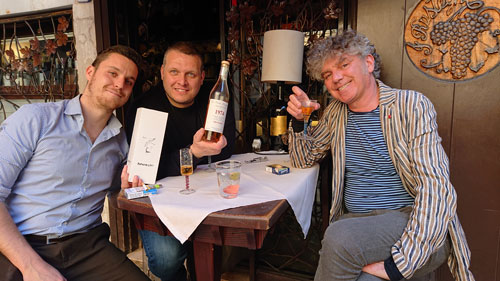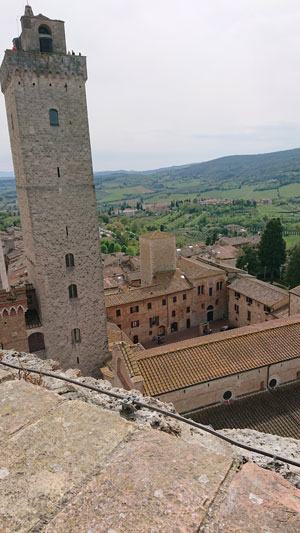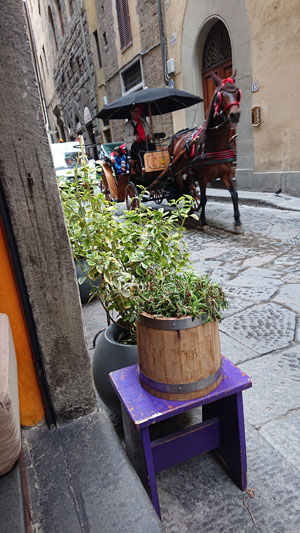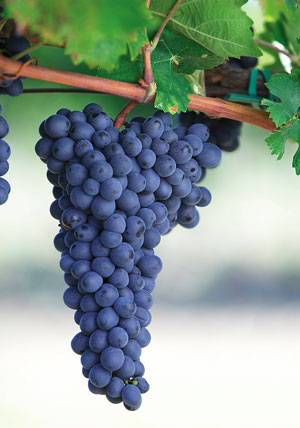Italian heritage abounds in North American winemaking; amateur and professional. In my own area of Sonoma County, California, long-time family wineries like Rafanelli, Sbragia, and Pedroncelli can be visited every day. We see the Italian influence at WineMaker magazine, too, with Editor Dawson Raspuzzi and contributing authors Dominick Profaci and Gene Spaziani. My predecessor for the “Techniques” column was esteemed Canadian-Italian author Daniel Pambianchi. When I was an owner of a home winemaking supply store, I often heard stories from current winemakers about how their grandparents made wine “in the old country” — Italy perhaps more often than anywhere else.
The Italian wine heritage was on my mind when my wife Marty and I began to plan a trip to Italy. Going for the first time, we vacationed for two weeks earlier this year, including Easter weekend. We traveled with three long-time friends who also enjoy and appreciate wine; one of those friends has previously helped me with harvest and winemaking in my own hobby vineyard. For our trip to Italy, I decided to talk to Italians about home winemaking in their country any time I had the opportunity. To help me do that, I took Introduction to Italian Language I and II at my local Santa Rosa Junior College in the months before our departure to Europe. I did not become fully fluent, but could speak enough to help me communicate with Italians I met while traveling.
We flew nonstop from Los Angeles, California to Zurich, Switzerland. There, we changed planes and flew to Venice, Italy. Staying in a charming boutique hotel near one of the famous canals, we set out exploring the city and its environs. One day, all the rest of my party took a boat to Murano Island to see the famous glass factories. With my principal interests elsewhere, I walked around town to find an enoteca (wine bar) that Marty had seen recommended on a travel website. At Enoteca Rusteghi, I greeted the owner, Giovanni, and asked for a wine recommendation. After sitting in the sunny courtyard and enjoying his suggested white blend, I approached Giovanni and two of his friends to get another glass of wine. He said, “here, drink this” and poured a splash of 1974 vintage Italian brandy into my glass. He had celebrated his forty-fifth birthday the day before and the 45-year-old brandy was one of the gifts. He introduced me to his friends Jonny and Paolo from Trieste. Jonny trades in truffles, but makes wine at home with his family. He uses local Malvasia grapes and described equipment and techniques a lot like I use at home (most North American home winemaking equipment is, after all, Italian-made). He does not use wine-enhancing products as I often do, relying on indigenous yeast for primary fermentation. The other friend, Paolo, is a professional distiller who gifted me a 200 mL bottle of his Amaro di Erbe Trieste. At 80 proof (40% ABV), it is a potent spirit infused with hops, gentian, dandelion, cinnamon, and more. More wine was poured, a French couple joined the group, and pretty soon English, Italian, and French were all mixed into the conversation for a delightful introduction to wine stories in Italy.

Our next wine adventure took place in Tuscany after a high-speed rail trip from Venice to Florence. In Florence, we rented a car and drove out to San Gimignano, a medieval tower city in the countryside. Just outside of town, we checked into an “agriturismo” called Fattoria Abbazia Monte Oliveto. This working winery and olive oil producer with seven comfortable apartments is right beside the abbey (Abbazia) on Monte Oliveto. The Fattoria has extensive plantings of grapevines and olive trees while still being within walking distance of San Gimignano itself. In the estate tasting room on the property, we discovered a wine grape that was new to me: Vernaccia. It is a white grape that produces crisp, refreshing wines with both fruitiness and minerality.

Our hostess, Mariana, explained that Vernaccia is very widely planted around San Gimignano and we went on to see — and taste — many more of these wines over the course of our stay. Asked about home winegrowing in the region, she said some Vernaccia was grown in backyards and made at home, but that most families made red wine as the house supply. Most of that is made from Sangiovese grapes, the primary grape of Chianti. Later, during a trip into town, I spent a pleasant visit chatting with Andrea, the proprietor of one of the several wine bars there. He told me that the region grows over 50 recognized sub-varieties of Sangiovese. (The Foundation Plant Services lists 30 clones of Sangiovese available, there are probably many more, just not available through FPS though.) He said home winemaking is very popular in the countryside around there, with some of the older home vineyards comprising varieties that have been propagated down through generations and may not even have a specific varietal identity — but almost all make red wine! On the walk back to the Fattoria, I spotted a familiar piece of equipment in the side yard of a home: The typical 14-gallon (54-L) demijohn that I used to sell in my shop. Whether tasting in wine bars, ordering in restaurants, or visiting nearby wineries, people were eager to tell us about Tuscan wines. While there were certainly some Chardonnay and Pinot Noir (or Pinot Nero) wines available, the local wine- scape was dominated by Vernaccia for white and the Chianti-type grapes for red, primarily Sangiovese and Canaiolo.
We drove back to Florence, turned in the rental, and set off on foot for the charming Hotel Alessandra near the famous Ponte Vecchio over the Arno River. Adventures ensued and museums were visited, but the best information I found about winemaking traditions came from right across the street. Mangiafoco Caffè describes itself as an “osteria, gastronomia, enoteca e tartuferia.” Far more than a pub that specializes in wine and truffles, it features a set of French doors that open right onto the street where you can enjoy a glass of wine and watch the people, horse carts, and occasional cars pass just a few feet away.

One afternoon our party scattered in different directions to tour churches, shop for jewelry, or see the sights. Where does Bob go? Across the street to Mangiafoco to ask more questions about wine! I sat at the street-side table and asked my server about home winemaking (in my limited Italian). She told me that it remained very popular with country families and offered to bring the owner, Francesco Nuti, out to speak with me. Francesco was very friendly and recognizing that his English had limits similar to my Italian, he called out Sofia Lepri, another server there, who is fully bilingual.
As I enjoyed a glass (or two) of Vernaccia di San Gimignano, Francesco and Sofia generously answered my questions and gave me insights into the home wine culture of Tuscany. Along with friends, Francesco himself had done some small-scale production in San Vincenti, about 45 miles (70 km) outside of Florence. They told me that many rural families make wine for the household every year, but to sell it commercially would require legal registration and payment of taxes. They told me that most households have their own basic equipment, although sometimes neighbors work together to share the labor and expense. Echoing what I had learned in San Gimignano, most families make red wine at home. I was not surprised when Francesco told me they use a number of Sangiovese clones, including some we see in California like Sangiovese Grosso. He also told me about small holdings of a formerly popular Chianti grape — Pugnitello — that I have never run across. I was interested to hear that almost all of the homemade wine is grown at home or on small nearby family farms and almost none is made from commercially-purchased grapes. I told Francesco and Sofia that things are much different near my home in Sonoma County with many home winemakers buying grapes at harvest from commercial vineyards. They were intrigued to hear that other home winemakers in the US use packaged juice kits or buy grapes that are picked, packed, and shipped for home winemaking. For these Italians, home winemaking is entirely a neighborhood activity.
He told me that the region grows over 50 recognized sub-varieties of Sangiovese . . .
That insight was reinforced for me after we got home. We attended a local wine tasting event in Petaluma, California along with Professoressa Terri Frongia, PhD, who had taught me the language skills I recently employed. At the wine tasting, we also met her husband Tony Frongia, who is originally from Sardinia. They confirmed the home winemaking stories I had heard in Florence and said it was much the same on Sardinia where Tony grew up. He told me that each family had a small plot of grapes, usually with more than one variety inter-planted. Since everyone works all week, home harvest would come on whatever Sunday most of the varieties were closest to ripe. Terri added that because the different grapes ripened at different rates, the wines could be dramatically different from one year to the next. She particularly remembered a year when the few white-wine grapes in the blend did especially well, producing a light red wine instead of the usual bold, heavy red. Tony explained that the dominant theme is that every family claims, “my wine is better than your wine.” Then he cheerfully confirmed that tradition by telling me why the heavier, more alcoholic Vernaccia of Sardinia is superior to the light, crisp Vernaccia of San Gimignano!
Lessons from Italy: Things I Might Do Differently
While home winemaking in Italy seems a lot like home winemaking here in Northern California, I did get some new insights that may join my winemaking hobby. I was especially taken by the focus on the land, the vineyard, and the neighborhood. In my own home vineyard, I will try to observe more closely throughout the growing season and help my grapes express “right here” more than some abstract target numbers. Along the same lines, I’ll be more flexible about vintage-to-vintage differences and strive to make exactly what this year’s weather is producing.
When I purchase grapes, I’ll also look for local expression. Along those lines, I’ll consider buying a batch of field-blend reds just to see what I get. I have only done one field blend before and I would like to explore those sources further. Finally, I’ll brag more about my wines. When I owned a home winemaking shop, I tried to be courteous about everyone else’s wine so as not to alienate customers. Now that I’m retired, I can take the neighborhood Italian approach: “My wine is better than yours!”






